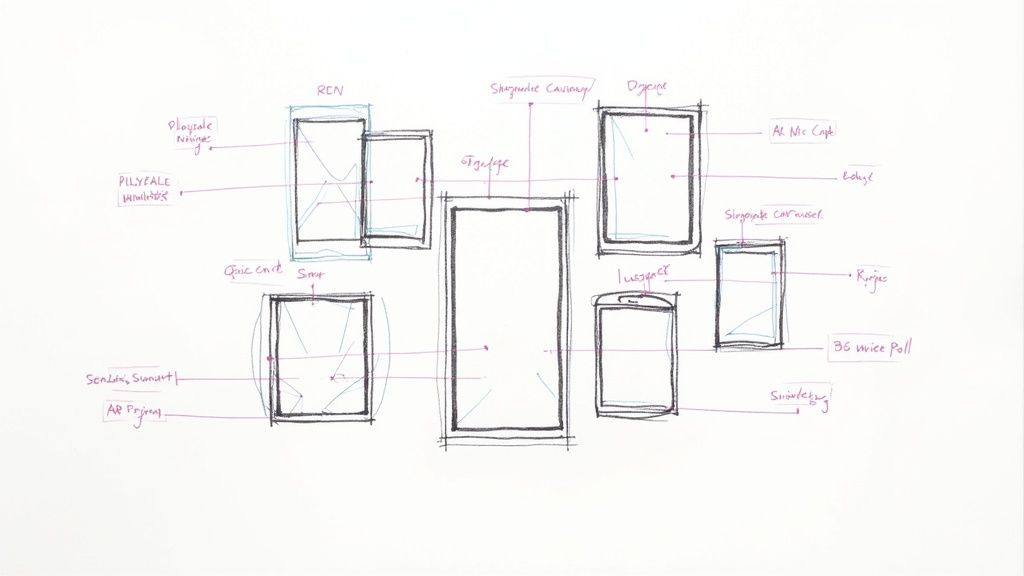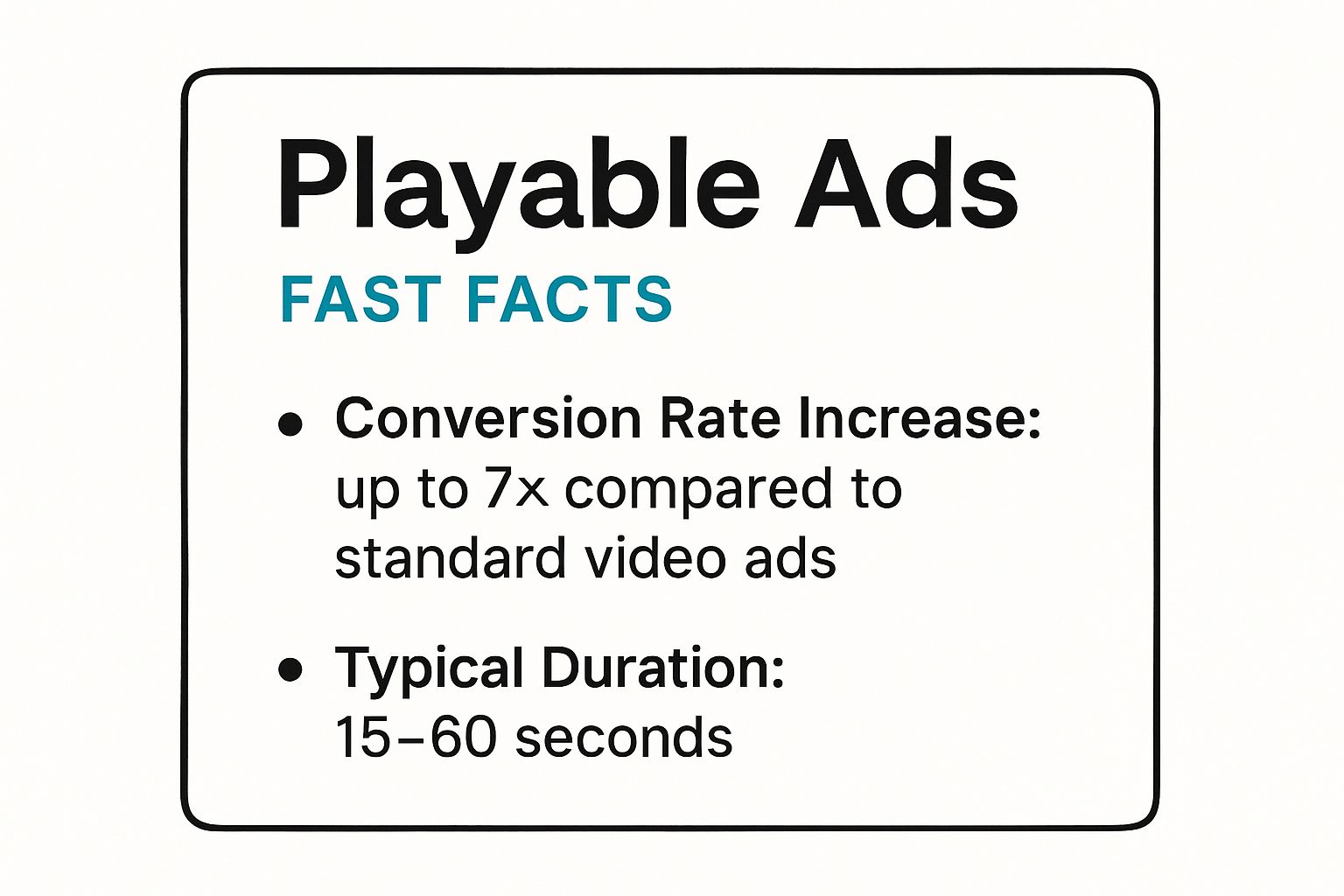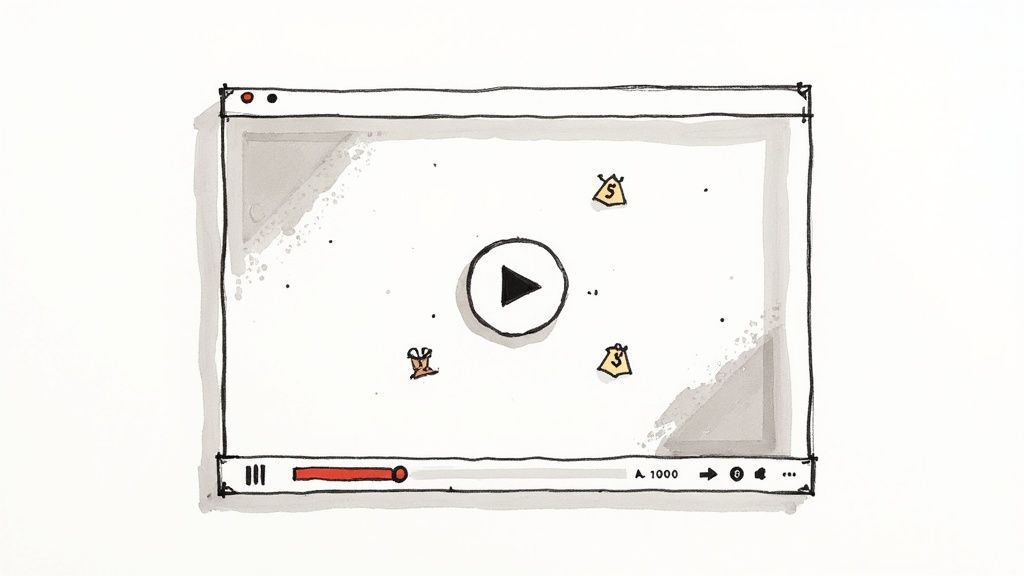
7 Standout Examples of Interactive Ads Dominating 2025
In an environment saturated with passive advertising, brands are struggling to capture and hold user attention. The traditional digital banner ad, once a staple, now often fades into the background, a victim of widespread "banner blindness." This is where interactive advertising transforms the dynamic from a one-way broadcast into a two-way conversation, turning viewers into active participants. The fundamental shift towards interactive ads is driven by the imperative to cut through the noise and genuinely connect with audiences. For marketing professionals seeking higher returns, the goal is no longer just to be seen, but to be experienced.
This article moves beyond theory to provide a deep dive into tangible examples of interactive ads that have successfully captivated users and driven results. We will dissect a curated selection of standout campaigns, analyzing the specific strategies and tactics that made them effective. From playable ads that offer a taste of a mobile game to shoppable videos that seamlessly merge content with commerce, each example serves as a practical blueprint.
You will not find surface-level descriptions here. Instead, you'll gain actionable takeaways and replicable methods for various formats, including:
- Playable & Gamified Ads
- Augmented Reality (AR) Experiences
- Shoppable & Interactive Video
- 360-Degree Video Ads
- Social Media Polls and Quizzes
By examining these real-world campaigns, you'll understand how to apply similar principles to your own marketing efforts. The objective is to equip you with the strategic insights needed to not only increase social media engagement but also to build memorable brand interactions that foster loyalty and boost conversion rates across all digital platforms. Let's explore the campaigns setting the new standard for digital advertising.
1. Playable Ads
At the forefront of interactive advertising, playable ads represent a powerful shift from passive viewing to active participation. These ad formats are essentially interactive, bite-sized demos that allow users to experience a core feature of a game or app directly within the ad unit itself. Instead of just watching a video of gameplay, the user gets to play a simplified, 15-60 second version, offering a genuine "try before you buy" experience.
This hands-on approach is one of the most compelling examples of interactive ads because it directly addresses user skepticism and reduces the friction of discovery. For mobile game developers like King (Candy Crush Saga) and Supercell (Clash Royale), playable ads have become a cornerstone of user acquisition. They isolate a single, satisfying game mechanic, like matching three candies or deploying a single troop, and present it as a mini-challenge. This method provides immediate gratification and an authentic preview of the full app's value proposition.
Strategic Breakdown and Insights
The genius of playable ads lies in their ability to pre-qualify users. An individual who engages with and completes a playable ad is significantly more likely to be a high-quality, long-term user than someone who simply clicks on a static banner. This is because they have already confirmed their interest in the core gameplay loop.
Platforms like Google AdMob, Unity Ads, and ironSource have popularized this format, providing the technology for developers to create and serve these mini-games at scale. The key is to balance simplicity with authenticity; the demo must be easy enough to complete in under a minute but representative enough to set accurate expectations for the full app.
Strategic Insight: Playable ads function as a powerful filtering mechanism. They attract users with a genuine interest in the product's core experience, leading to higher conversion rates and improved user retention post-install.
This summary box highlights the key performance metrics that make playable ads a go-to format.

The data clearly shows that offering a brief, interactive preview can boost conversions dramatically compared to traditional, non-interactive video ads.
Actionable Takeaways for Marketers
To successfully implement playable ads, focus on the following tactics:
- Simplify the Core Loop: Isolate the single most satisfying action in your app and build the ad around it. Avoid complex tutorials or multiple mechanics.
- Optimize for a 3-Second Hook: The initial interaction must be intuitive and immediately engaging. Use clear visual cues and animations to guide the user's first action.
- Include a Clear Call-to-Action (CTA): After the user completes the demo, a prominent CTA like "Continue Playing" or "Download Now" should seamlessly transition them to the app store.
- A/B Test Difficulty: Test different levels of difficulty. If it's too hard, users will drop off; if it's too easy, they may get bored. Find the sweet spot that maximizes completion rates.
2. Augmented Reality (AR) Ads
Augmented Reality (AR) ads represent a groundbreaking frontier in advertising, seamlessly blending the digital and physical worlds. These sophisticated examples of interactive ads use a smartphone's camera to overlay computer-generated images, animations, or information onto a user's real-world view. This allows consumers to visualize products in their own space, "try on" items virtually, and engage with brands in a deeply personal and immersive context.

Unlike other ad formats that exist entirely on a screen, AR brings the product into the consumer's life before a purchase is ever made. Brands like IKEA with their IKEA Place app, which lets users see how furniture would look in their homes, and Sephora with its Virtual Artist feature for trying on makeup, have pioneered this space. These ads effectively remove major purchase barriers, such as uncertainty about size, fit, or style, by providing a practical and engaging solution.
Strategic Breakdown and Insights
The strategic power of AR ads comes from their utility. They are not just entertaining; they solve a real customer problem. By allowing a user to see if a couch fits their living room or if a shade of lipstick complements their skin tone, the ad transforms from a mere promotion into a valuable decision-making tool. This utility builds trust and significantly shortens the consideration phase of the customer journey.
This format has been heavily popularized and made accessible through platforms like Snapchat, Instagram/Facebook filters, and the underlying technology of Apple's ARKit and Google's ARCore. These platforms provide the infrastructure for creating and deploying AR experiences to massive audiences, turning a once-niche technology into a mainstream marketing channel. The key is to create an experience that is both technologically seamless and contextually relevant to the user's environment.
Strategic Insight: AR ads create a powerful psychological effect known as the "endowment effect." By allowing users to place a virtual product in their personal space, they begin to feel a sense of ownership, making them much more likely to complete the purchase.
This summary box highlights the key benefit that makes AR ads a uniquely persuasive format. The interaction moves beyond simple engagement to create a tangible connection between the consumer, the product, and their personal environment, driving high-intent conversions.
Actionable Takeaways for Marketers
To successfully implement AR ads, focus on the following tactics:
- Solve a Real Pain Point: Don't use AR just for novelty. Focus on solving a common customer problem, like visualizing product size, fit, or color matching.
- Provide Simple Instructions: Many users will be new to AR. Use clear, simple on-screen guides to show them how to scan their environment and place the virtual object.
- Optimize for Performance: Ensure your AR experience loads quickly and runs smoothly across a range of devices. Test performance in various lighting conditions to prevent user frustration.
- Integrate a "Share" Feature: Make it easy for users to take a photo or video of their AR experience and share it on social media. This turns your ad into a source of user-generated content and organic promotion.
3. Shoppable Video Ads
Bridging the gap between brand storytelling and e-commerce, shoppable video ads transform passive viewing into an immediate, transactional experience. These ads integrate clickable hotspots or product tags directly into the video content, allowing viewers to tap on an item they see, view its details, and add it to their cart without ever leaving the video player. This format effectively collapses the sales funnel, turning a moment of inspiration into an instant purchase opportunity.

This evolution of video marketing is a powerful example of interactive ads because it directly addresses the challenge of converting viewer interest into tangible sales. Major platforms have deeply integrated this functionality; examples include Instagram's shopping tags in video posts, YouTube's merchandise shelf for creator content, and TikTok's commerce partnerships. These tools empower brands to create immersive, narrative-driven ads that are also powerful direct-response sales channels.
Strategic Breakdown and Insights
The primary strength of shoppable video is its ability to reduce purchase friction to nearly zero. By capturing consumers at their peak point of interest, it bypasses the traditional customer journey of seeing a product, remembering it, searching for it later, and finally making a purchase. The interaction happens in the moment, driven by the visual and emotional appeal of the video content.
This format thrives on social commerce platforms where users are already in a discovery mindset. Brands can leverage influencer collaborations or user-generated content, adding a layer of authenticity and social proof to the shoppable experience. The key is a seamless integration that enhances, rather than disrupts, the viewing experience. For a deeper look into the mechanics and potential of this format, you can find a comprehensive guide on interactive shoppable video.
Strategic Insight: Shoppable video capitalizes on the "inspiration impulse" by making the path from discovery to purchase instantaneous. This significantly boosts conversion rates by eliminating the steps where a potential customer is most likely to drop off.
This summary highlights how the format shortens the sales cycle and drives direct revenue.
Actionable Takeaways for Marketers
To effectively leverage shoppable video ads, marketers should implement the following strategies:
- Balance Narrative and Commerce: Ensure the shopping elements feel like a natural extension of the story. The primary focus should still be on creating engaging video content, with product tags serving as a helpful, non-intrusive feature.
- Use Subtle Visual Cues: Don't overload the screen with icons. Use clean, subtle visual indicators like a small dot or a gentle pulse to signify a clickable product. The cue should be noticeable but not distracting.
- Optimize the Mobile Experience: The vast majority of these ads are viewed on mobile devices. Ensure the product pop-up, details, and add-to-cart process are fully optimized for small screens and touch-based interaction.
- A/B Test Hotspot Placement and Timing: Experiment with when and where product tags appear. Test whether tags that appear as the item is being used are more effective than a summary of all items at the end of the video.
4. Interactive Video Ads
Moving beyond static playback, interactive video ads transform passive viewing into an immersive, participatory experience. These ads embed clickable elements, polls, quizzes, or even complex branching narratives directly into the video stream, allowing viewers to control the direction of the content. Instead of simply watching a story unfold, the user becomes an active agent in shaping it.
This format is one of the most dynamic examples of interactive ads because it leverages the high engagement of video with the personal investment of choice. Brands like Honda, with its famous "The Other Side" campaign, demonstrated the power of this format by allowing users to switch between two parallel narratives in real-time. Similarly, Netflix’s Black Mirror: Bandersnatch took this concept to the mainstream, creating a full-length "choose-your-own-adventure" film that captivated audiences and blurred the lines between entertainment and advertising.
Strategic Breakdown and Insights
The core strength of interactive video is its ability to foster a deeper, more memorable connection between the viewer and the brand. By giving the user control, the ad becomes a personal journey rather than a one-size-fits-all broadcast. This active participation dramatically increases engagement time and brand recall compared to linear video.
Platforms like YouTube and dedicated interactive video hosts like Brightcove have built the infrastructure to support these complex experiences. The key is creating content where user choices feel meaningful and lead to genuinely different outcomes. This approach not only entertains but also generates valuable data on user preferences, revealing which product features, narrative themes, or calls-to-action resonate most. As more platforms integrate these features, the potential for creating truly personalized video funnels at scale grows.
Strategic Insight: Interactive video ads turn a monologue into a dialogue. They empower users to guide the narrative, which transforms the ad from an interruption into a co-created experience, significantly boosting engagement and message retention.
This deeper level of interaction provides rich analytics, allowing marketers to understand user choices and optimize future campaigns based on demonstrated behavior rather than assumptions. You can find more in-depth information about creating these experiences by exploring a guide to interactive video ads.
The Honda campaign above is a classic example, showing how a simple toggle mechanic can create a powerful and compelling dual narrative.
Actionable Takeaways for Marketers
To create effective interactive video ads, consider these key strategies:
- Map Every Journey: Before filming, meticulously storyboard all possible user paths and outcomes. A clear decision tree is essential for a coherent and bug-free experience.
- Make Interactions Intuitive: Use clear visual prompts, on-screen text, or distinct "hotspots" to signal interactive elements. The user should never feel confused about when or how to interact.
- Ensure Each Path Adds Value: Every branching narrative should offer a unique perspective or piece of information. Avoid choices that lead to nearly identical outcomes, as this can make the interaction feel superficial.
- Design for Mobile-First: Interactions should be easy to execute with a thumb tap. Ensure buttons and clickable zones are large enough and responsive on smaller screens.
5. Gamified Banner Ads
Gamified banner ads elevate traditional display advertising by embedding simple, interactive game mechanics directly into the banner format. Instead of a static image or a passive video, users encounter mini-games, puzzles, or challenges that invite immediate interaction. This approach transforms a standard ad space into an engaging brand playground, capturing attention in a crowded digital landscape.

This tactic cleverly combats "banner blindness," where users habitually ignore ad placements. By presenting a simple challenge, such as a scratch-off game from McDonald's or a chip-catching game from Doritos, brands can spark curiosity and encourage a moment of active engagement. The goal is to create a positive, memorable brand interaction that boosts awareness and click-through rates far beyond what a static banner could achieve.
Strategic Breakdown and Insights
The primary advantage of gamified banners is their ability to increase ad dwell time and brand recall. When a user spends even 10-15 seconds playing a simple game, they are forming a much stronger cognitive and emotional connection with the brand than they would from a fleeting glance. This makes them one of the most effective examples of interactive ads for top-of-funnel awareness campaigns.
Platforms like the Google Display Network and The Trade Desk have enabled the widespread distribution of these rich media formats. The key to success is integrating the brand naturally within the game. For instance, a Kit Kat banner ad might feature a puzzle where the user has to "break" the chocolate bar, reinforcing the brand's iconic slogan and product identity in a playful manner.
Strategic Insight: Gamified banners excel at transforming ad impressions from passive views into active, positive brand experiences. This micro-engagement significantly enhances brand recall and user sentiment, making the ad spend more impactful.
This strategy is particularly powerful for CPG brands and entertainment companies looking to build affinity and keep their products top-of-mind in a fun, non-intrusive way.
Actionable Takeaways for Marketers
To effectively deploy gamified banner ads, consider these core strategies:
- Keep Mechanics Simple: The game should be instantly understandable and playable with a single click or tap. Think simple puzzles, matching games, or "point and shoot" mechanics.
- Ensure Natural Brand Integration: The product or brand identity should be central to the gameplay, not just an afterthought. The game should feel like a natural extension of the brand's personality.
- Optimize for Mobile Touch: Design the ad with a mobile-first mindset. Ensure buttons and interactive elements are large enough and responsive to touch inputs for a seamless experience on any device.
- End with a Clear CTA: After the brief gameplay, guide the user to the next step with a compelling call-to-action, such as "Learn More," "Shop Now," or "Claim Your Coupon."
6. 360-Degree Video Ads
Stepping beyond the flat screen, 360-degree video ads plunge users into a fully immersive environment. These ads utilize spherical video that allows viewers to explore a scene from every angle by physically moving their phone, tilting their device, or dragging their cursor on a desktop. This format transforms passive viewing into an act of discovery, empowering the user to direct their own experience and look wherever they choose within the ad's world.
This powerful sense of presence makes 360-degree video one of the most compelling examples of interactive ads for industries where spatial context is paramount. It gives the user a virtual "you are there" feeling that a standard video cannot replicate. Brands like Marriott have used it to transport viewers to exotic destinations, while automakers such as Volvo have placed users directly in the driver's seat of a new car. The interaction is simple yet profound, fostering a deeper connection and sense of ownership over the experience.
Strategic Breakdown and Insights
The core value of 360-degree video ads lies in creating digital presence and emotional resonance. By giving users control over the camera, brands can generate genuine curiosity and longer engagement times compared to linear video. The user isn't just watching a story; they are exploring a world, which makes the brand message feel less like an advertisement and more like an experience.
This format has been championed by platforms like YouTube 360 and Facebook 360, which have integrated the technology to make it accessible to mass audiences. The key to a successful 360-degree ad is not just filming in 360 degrees but designing an environment rich with details to discover. The goal is to encourage exploration and reward the user's attention with meaningful content no matter where they look.
Strategic Insight: 360-degree video ads excel at building brand affinity by trading a forced narrative for user-led exploration. This freedom creates a more memorable and positive brand interaction, boosting key metrics like view duration and brand recall.
This approach is highly effective for showcasing environments, products, and experiences in a way that feels authentic and personally directed.
Actionable Takeaways for Marketers
To effectively implement 360-degree video ads, focus on the following strategies:
- Design for Discovery: Place key brand messages, products, or narrative events in multiple locations within the 360-degree space. This rewards users for exploring and ensures they don’t miss the core message.
- Guide with Audio Cues: Use spatial audio to subtly direct the user's attention. A sound coming from "behind" the user will naturally prompt them to turn around and see what’s there.
- Provide Clear Instructions: At the start of the ad, include a simple text overlay or visual cue like "Move your phone to look around." This ensures users who are new to the format understand how to interact.
- Prioritize a High-Fidelity Experience: The immersive effect depends on high-resolution video. A blurry or pixelated 360-degree video can break the sense of presence and create a poor user experience, so invest in quality production.
7. Social Media Poll and Quiz Ads
Tapping directly into the native features of social platforms, poll and quiz ads transform passive scrolling into an active dialogue. These ads leverage interactive elements like Instagram Story polls, Twitter polls, or sponsored BuzzFeed-style quizzes to engage users with direct questions. Instead of just pushing a message, brands invite users to share their opinions, test their knowledge, or discover something new about themselves.
This format thrives because it feels less like a traditional advertisement and more like native content. For example, a brand like Spotify might use a poll in an Instagram Story asking, "What's your ultimate workout vibe: High-Energy Pop or Heavy Metal?" The user's vote is a low-effort interaction that provides Spotify with valuable preference data. Similarly, a fashion brand can create a "Find Your Style" quiz, guiding users through a series of visual choices to deliver a personalized product recommendation, turning engagement directly into a sales opportunity.
Strategic Breakdown and Insights
The primary advantage of social media poll and quiz ads is their ability to gather zero-party data, which is information that a customer intentionally and proactively shares with a brand. This data is incredibly valuable for personalization and audience segmentation. When a user participates, they are not just engaging; they are willingly providing insights into their preferences, needs, and interests.
Platforms like Instagram, Facebook, and TikTok have integrated these features seamlessly into their ad formats, making them easy for marketers to implement. The key is to frame the interaction as a benefit to the user, whether it’s through entertainment (a fun quiz), self-discovery (a personality test), or validation (voting in a poll). These ads are a powerful tool for community building and making an audience feel heard.
Strategic Insight: Poll and quiz ads are a powerful form of conversational marketing. They open a two-way communication channel that gathers valuable customer data while simultaneously increasing engagement and making users feel like active participants in the brand's story.
This approach effectively turns advertising into a collaborative and data-rich experience, boosting both engagement metrics and market intelligence.
Actionable Takeaways for Marketers
To successfully deploy poll and quiz ads, focus on the following tactics:
- Ask Genuine Questions: Frame questions around topics your target audience genuinely cares about. Avoid overly promotional or leading questions that feel like a sales pitch.
- Provide Instant Value: Use the results to offer immediate, personalized feedback or recommendations. If a user completes a quiz, provide them with a tangible outcome, like a style profile or a product suggestion.
- Keep It Simple and Fast: Design your polls and quizzes to be completed quickly, ideally within a few seconds or taps. In the fast-paced social feed, brevity is essential.
- Connect to a Broader Campaign: Use the insights gathered to inform follow-up content. For instance, if a poll reveals a strong preference for a certain product feature, create subsequent ads or content that highlights it. This technique can also be applied to larger formats; for more inspiration, explore some interactive presentation ideas on mindstamp.com.
7 Examples of Interactive Ads Compared
Making Your Ads Interactive: Your Blueprint for 2025
Throughout this extensive gallery of interactive ad examples, a clear and powerful narrative emerges: the era of passive consumption is over. Audiences no longer tolerate being mere spectators; they demand to be participants. The campaigns we've analyzed, from immersive 360-degree videos to instantly gratifying playable ads, aren't just creative novelties. They represent a fundamental shift in the advertiser-consumer relationship, moving from a monologue to a dynamic, value-driven dialogue.
The strategic insights gleaned from these successful examples provide a robust blueprint for any brand looking to captivate and convert in an increasingly crowded digital landscape. The common thread isn't just technology for technology's sake. It's the strategic application of that technology to create a memorable and meaningful value exchange.
Key Takeaways: From Examples to Execution
As you move from inspiration to implementation, several core principles stand out as non-negotiable for success. These are the strategic pillars that support the most effective interactive campaigns.
- Value-First Engagement: Every interaction must offer something tangible to the user, whether it’s entertainment (gamified ads), utility (shoppable video), personalization (quizzes), or discovery (AR try-ons). The "what's in it for me?" question must be answered within seconds.
- Data as a Creative Tool: The best interactive ads are built on a feedback loop. Engagement data isn't just for post-campaign reports; it’s a real-time signal of user intent and preference. This data should inform creative iterations, A/B testing, and future campaign strategies, turning insights into action.
- Context is King: The platform dictates the format. A playable ad thrives in a mobile gaming environment, while an AR filter finds its home on social media stories. Understanding the user's mindset and native behaviors on each platform is critical to designing an interaction that feels natural, not disruptive.
- Simplicity Scales: The most brilliant interactive concepts are often the simplest to engage with. A single tap, a swipe, or a simple choice can be far more effective than a complex, multi-step process. Lowering the barrier to entry is paramount to maximizing participation and completion rates.
Your Actionable Next Steps
Observing great examples of interactive ads is the first step. Building your own is the next. Here is a practical roadmap to get started:
- Audit Your Audience and Goals: Before choosing a format, define what you want to achieve. Is it lead generation? Brand recall? Driving sales? Match the ad format to the objective. A quiz is great for segmentation, while a shoppable video is built for direct conversion.
- Start Small with Interactive Video: Of all the formats, interactive video offers one of the most accessible entry points. You can enhance existing video assets with clickable hotspots, questions, or branching narratives without needing a massive new production budget. This is a low-risk, high-reward way to test the waters.
- Choose a Platform, Not Just a Format: Instead of just saying "let's do an AR ad," specify "let's create an Instagram AR filter that lets users try on our new sunglasses." This focuses your strategy on a specific user experience and distribution channel, making execution far more manageable.
- Map the User Journey: Storyboard the interaction from the user’s perspective. What is the very first thing they see? What action do you want them to take? What happens after they click? A clear, simple user flow is the backbone of a high-performing interactive ad.
Mastering interactive advertising is no longer a "nice to have" skill for marketers; it is a core competency for survival and growth. By embracing these strategies, you’re not just creating ads. You are building experiences that capture attention, foster genuine connection, and drive measurable business results. The future of advertising is a conversation, and it’s time to start yours.
Ready to move beyond theory and start building your own powerful interactive experiences? Mindstamp makes it easy to transform your standard videos into engaging, clickable, and data-rich assets perfect for marketing, sales, and training. Turn your video content into a two-way conversation and see the results for yourself. Get started with Mindstamp today!
Get Started Now
Mindstamp is easy to use, incredibly capable, and supported by an amazing team. Join us!



Try Mindstamp Free










